This exhibition demonstrates an alternative "source code" of the types of art familiar to the viewer. We are talking about the thread, as the basis, the material, the core. The thread has an incredible ability to intertwine, interpenetrate, thereby creating bizarre patterns, whole fabrics, an unreal reality. It is the thread that inspires many contemporary artists to create incredible works. Some artists use it traditionally to create a fabric, for example, modern tapestries. Artists turn to the thread, seeing in it an alternative to the usual colors. Each thread - as if a separate stroke, a line that has its own already defined manner, color. Thus, "paintings" are obtained on the verge of painting and sculpture. With the help of a thread, artists turn to architecture, creating whole miniature cities. In this case, the thread generates a structure, a framework of architecture. Separate attention should be paid to sculpture and installation - these types of art also turn to threads, use its subtlety, ephemeral, color gradation. But the most surprising is that the thread becomes the designer of space, the link, it fills the whole room, fancifully interwoven, changing points of perception, habitual objects. The exhibition invites everyone to trace the evolution of the thread in contemporary art, to read the "source code" in each work.
Don't wanna be here? Send us removal request.
Photo
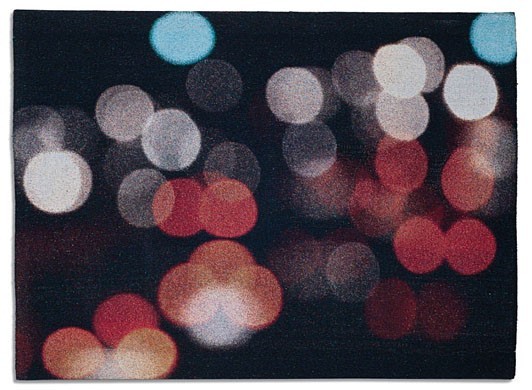
Grethe Sorensen
10gs Rush Hour Shanghai, handwoven cotton, 28" x 38", 2011
The thread is the traditional basis for making trellises in this work. This type of art can not exist without this basic nucleus.
This work is part of a series of “Traces of light”, based on video recording of artificial light from headlights, signs, traffic lights at night in Shanghai. Incredible color effects are created with the help of a defocused camera that turns the lights into amazing translucent circles. Thus, the city seems to be revealed at the cellular level. Moreover, to transfer individual frames from the video into the fabric structure, the artist used new technologies of digitization. She reduces the number of pixels in the frame to eight primary colors. Then on a hand-held machine with the use of modern technologies, the pixels are replaced with threads. Grethe Sorensen explores new technologies and seeks to discover new ways of transforming digital elements into tangible woven objects from thread designs.
In this way , the thread creates the illusion of depth, structure, materiality, relief and intensity of color.
1 note
·
View note
Photo
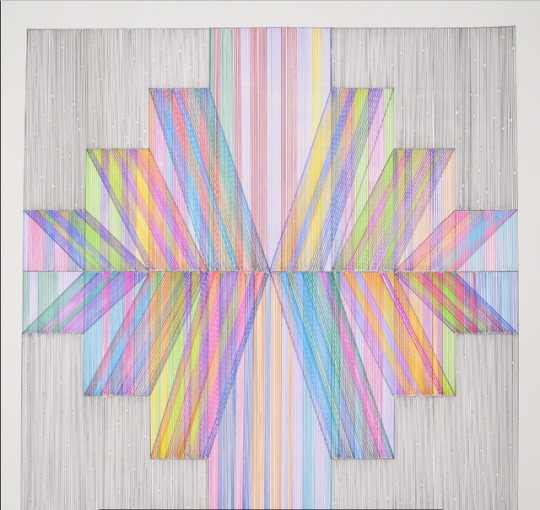
Adrian Esparza
Cities, 2017
Pencil, felt pen on Bristol board
45.7 × 45.7 cm
The artist creates pictures not on the basis of colors, but on the basis of a thread. Paying tribute to his Mexican roots, he uses a thread from traditional Mexican clothes - sarap. Thus, he deconstructs the Mexican sarap, inspired by traditional Mexican geometric patterns, characterized by a smooth color change, polychrome.
In addition, Esparza was influenced by minimalists, who also used simple geometric shapes, mesh constructions, neutral surfaces, etc. The influences of modernist architecture are also noticeable with its striving for simple forms, pure futuristic spaces. According to the artist, he finds modernist architectural structures from around the world using the Google search engine. Inspired by landscapes and architecture, Esparaza talks about the diffusion of color and the expansion of space.
The thread in his works is the first element that forms the structure, the construction, and also the volume.
0 notes
Photo
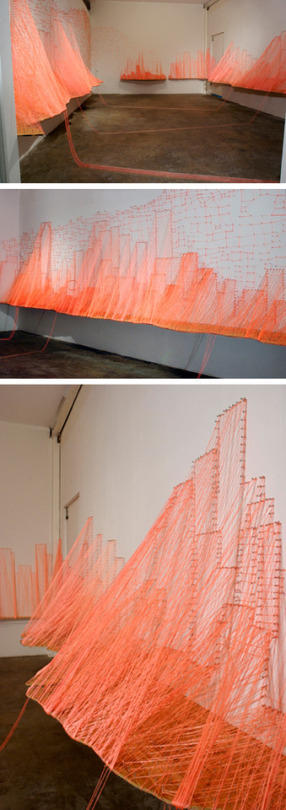
Aili Schmeltz
The Magic City 2008
This project is an ode to the American city of Miami, the second name of which is “The Magic City”. The project is based on aerial photographs.
The artist chose the orange color of the thread, as it best conveys the warm climate of the city, the bright sun, the beach, hedonism.
One of the main elements of the work are bridges that connect the left and right parts of the “city”. They add visual complexity, they are the logical link.
There is a feeling that this is a city of dreams, the city is a magical country. The structure is located just above the floor, which creates the illusion of ephemeral. Thus, the projecting boards cast shadows - create the illusion of clouds. The city seems to float across the sky or swinging on the waves.
The thread plays a very important role - it is not only a construct, a basis, but also forms different points of view. If you look at the “city” from the side, the thread creates the illusion of a mountain, something massive. However, it is worthwhile to approach frontal, as soon as you can see outlines, light structures. In addition, the thread makes an effect of something light, weightless, magical - which the artist wanted to achieve.
1 note
·
View note
Photo
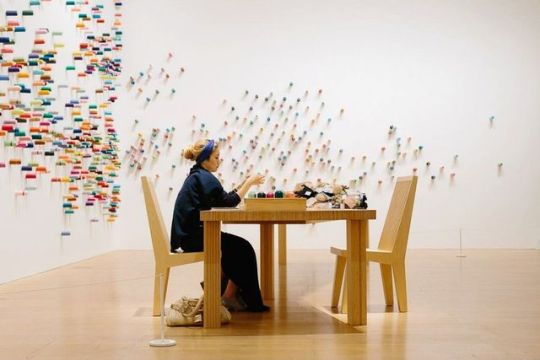
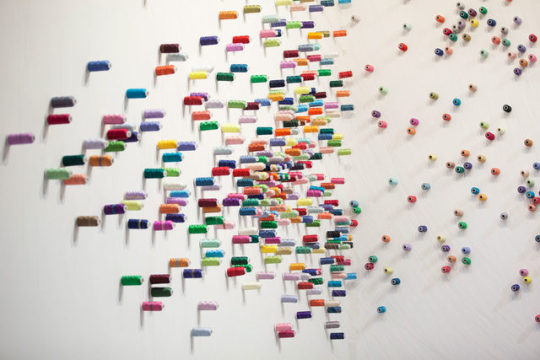
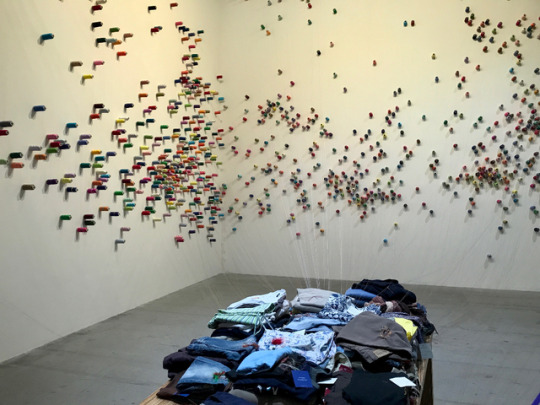
Lee Mingwei
The Mending Project, 2009
The atrist explores the idea of trust and intimacy between strangers through the act of repairing clothes. The artist demonstrates the democracy of art, its openness to exchange between all people. Communication is established not only between artists and a particular visitor who sits at the table and waits for a fix, but also with all subsequent guests. The artist resorts to the thread to express these ideas.
In this installation, the thread is a magnificent metaphor, consisting how the thread is able to form something coherent from isolated elements. The thread and idea of installation, showing openness, readiness for universal exchange, communication, are in syntagmatic relations – if one element is deleted, the meaning is lost.
0 notes
Photo
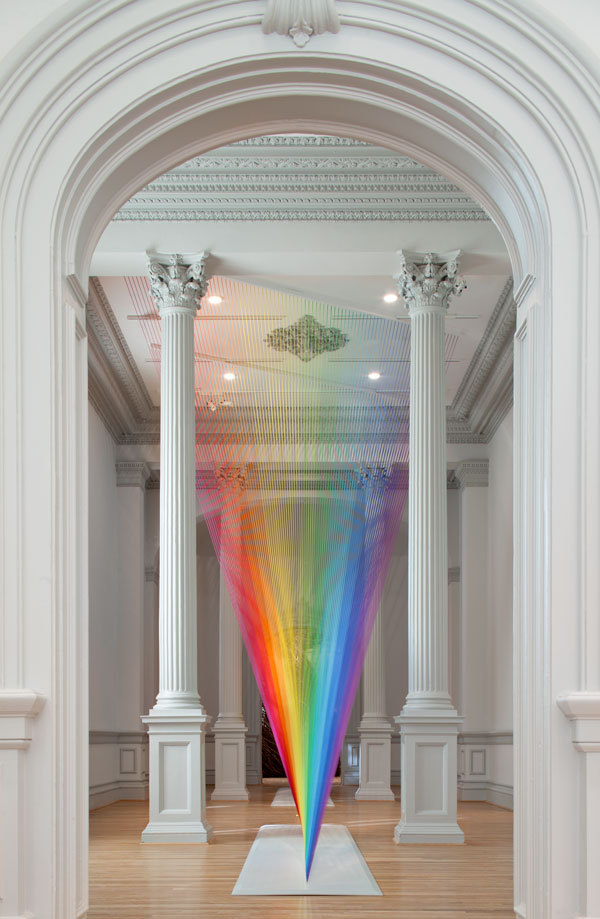
Gabriel Daw
Plexus a1 + site specific installation at the smithsonian american art museum’s renwick gallery + gütermann thread, painted wood and hooks + 25’ x 12’ x 40’ + 2015
The creator of these rainbow prisms discusses the need of a person in a shelter. The artist takes the basic material from which the clothing consists - the thread, and creates an architectural structure. The connection between clothing and architecture is not accidental, since one of their most important functions is protective. Thus, changing the angle of view, scale, material, the artist creates a symbolic social construct.
Light and color play an important role. It is such a thin material as a thread on such a large scale that creates the illusion of ephemerality, waving. These works - a kind of optical art, because it is worth going around, as the work begins to shimmer, change the color.
It is worth noting the trend that many artists working with the thread, influenced the Mexican folk art. Also, Daw keeps memories of Mexico, uses a characteristic bright color and patterns.
The thread helps the artist to materialize the light, to show the viewer inaccessible things, using the color spectrum to show unity and integrity.
0 notes
Photo
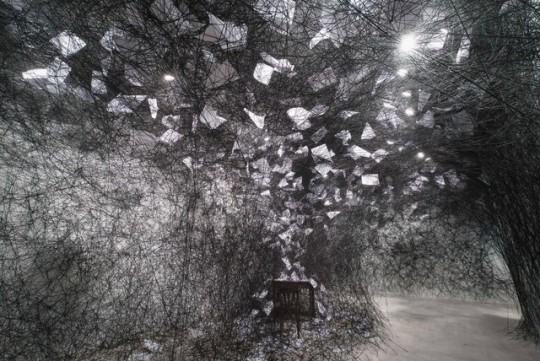
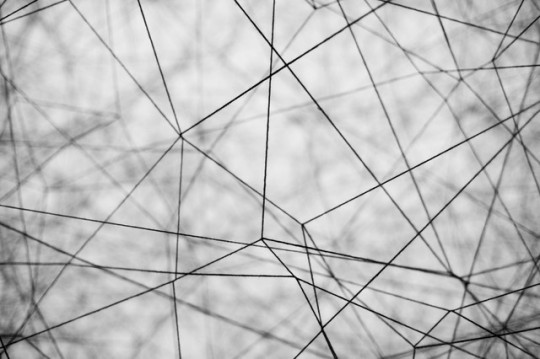
CHIHARU SHIOTA
A Long Day
2015
Thread, Table, Chair, Paper
The artist uses the thread on a different level. With it help, she creates not just a specific kind of art, but creates a whole spatial context. Often, Shiota includes in its installations supported things that have memories. It is the complex interweaving of threads that bind all objects, create a semantic layer. The artist talks about memory, temporality, transcendental.
It is interesting that the artist usually does not think in advance the final version of the exposition, does not sketch. She draws inspiration directly on the spot, creates things for herself, improvisation.
The intertwining of the threads erases the line between dream, fantasy and reality. They demonstrate the interdependence of all elements of nature, reflect the invisible ties of all things.
Thus, the thread in the works of Shiota creates a material field, a space in which objects solidify.
0 notes
Text
Grethe Sorensen
The artist was a descendant of the masters of The Manufacture des Gobelins. Her ancestors were masters at the manufactory at the court of Henry 4! In the archive, the artist even has a letter from her distant relative, who was approached by Charles Lebrun - an artist who was at the head of the manufactory in the 17th century. In this letter it was reported that Ms. Zhuvinal Monroe had the right to enter the workshop at the manufactory. For that time it was a real nonsense! Women did not have access to such facilities. However, Zhuvinal not only managed to create tapestries for the king, but kept the secret of production for posterity. She led a whole diary, where she carefully wrote down everything. Later, the Monroe family had to leave France and move to Denmark. However, the skill was passed down from generation to generation. Grethe recalls that she found this diary of her ancestor in one of the boxes. She approached this diary with great care. She knew that everyone in her family was traditionally engaged in tapestries. But the finding of this diary allowed Grethe to add to her work a particle of antiquity - the secrets of the royal manufactory of France.
Adrian Esparza
The artist remembers how he grew up in Mexico. He absorbed the whole essence of his country - from the bright sun to the ardent inhabitants. Everyone in his family wore traditional clothes - a sarap. It resembled a poncho, a cloak sewn from many bright pieces of fabric. Such clothes fit in picturesque Mexico. Motley colors have become an integral part of young Adrian. True, when he was 16 years old, his mother took the boy to the US, where he went to exhibitions of contemporary art. There he saw the popular minimalists. For him it was a real shock - after a bright, succulent life in Mexico. It is these two principles - the pulsation of life, the elemental principle and minimalism, laconicism, simplicity intertwined in the artist's work.
Aili Schmeltz
The artist says that her work is influenced by dreams. They are always bright and alive, and she is a participant. Once in her life everything was just awful. She divorced her husband, quarreled with her parents, fell ill. Her despair was boundless. In this difficult period, she had a dream that turned out to be fateful. In her dream, she moved to an unknown city, which seemed to be filled with happiness. All the houses, streets, trees were bright orange. Everything was shining and drowning in bliss. Aili walked on it and was very happy. All problems disappeared from her head. In this city there were no people - sources of conflicts, there were no debris and dirt. There was only Aili and a beautiful city. When she woke up, she realized that the best way to solve all problems was to travel. Her first destination was Miami. As soon as she came here, she immediately had realized that this was her place from dreams. Then she decided to create an installation that embodied her dreams and this beautiful city.
Gabriel Daw
The artist says that he knows who he was in a past life. It's hard to believe, but he was a fairy! Yes, that's what he always says. When he was small, his first word was "magic." In his school years Gabriel made himself a magic wand and believed that it works wonders. To his friends, he said that, in fact, his name is Dinh-Dinh, and in a past life he saved the children with the help of magic. His close friends believed him, and strangers laughed. When the artist grew, he realized that all his hidden talents and dreams can be realized only through art. He began to create wonderful works, truly filled with magic. They were like a rainbow or the atmosphere of a fairy-tale planet. The artist says that this is how everything was in his past life.
CHIHARU SHIOTA
It turns out that the source of her work is love for spiders! The artist tells that in her childhood she always dreamed of a pet. However, her parents did not allow her. One day the girl brought home a spider. It was small, and no one noticed it. She put it in a box and looked after it. Over time, they became best friends. Chihary could tell all her secrets only to a spider. The most exciting for the girl were the webs that created her spider. They were very beautiful, thin and graceful. The girl dreamed of creating the same. Unfortunately, the spider had died soon. The girl was sad for a long time, but promised that she would find a way to create a web. When she grew up, she became an artist. Now, in almost every work, we find fancy weave threads that remind us of cobwebs.
Biographies are not based on real events.
1 note
·
View note
Text
Interview with Nadezhda Blazhko, online exhibition Thread-like base
Interview with Nadezhda Blazhko, online exhibition Thread-like base
Interview by Kamila Narysheva
20. 10. 2017
1) Please, explain the thought process behind the concept of your biannual.
It all started with my acquaintance with the works of Chiharu Shiota. She has long been working with such unusual artistic material as a thread. I became a big fan of her work. Then I began to wonder if other contemporary artists are working with such a material in an unconventional way. I wanted to see if those artists created paintings, sculptures. Alternatively, someone like Chiharu Shiota could think of a thread in incredible concepts.
2) What was the research process like? How did you manage to find project that were suited for your idea?
Finding the right work was not easy! The simplest for me was the search for modern trellises. In the St. Petersburg Institute of Culture, where I studied, there was a fine course in textiles and fabrics. There I had discovered modern trellises. Artists use traditional materials, sometimes modern technologies are added. In many ways, the Internet project Artsy, which seeks to unite the world of contemporary art in the Internet environment, has helped. I'm subscribed to many galleries and that’s where I have found right works for me.
In fact, as I often do - if I'm looking for something very diligently - the right things find me by themselves!
3) Why did you decide to work with the imagery of threads?
My answer will be almost the same as to the first question. I was inspired by the Japanese artist Chiharu Shiota. I will also add that the thread is, indeed, quite a non-standard material for sculpture, paintings, installations. In fact, I wanted to understand why the artists decided to work with this material. The projects turned out to be very interesting and different. All artist did not choose the thread by an accident. In fact, my curatorial project explores what message does the thread carry as a material in every kind of art.
4) What would you say was the most challenging when describing your overall idea and tying all projects together?
In fact, it was not difficult for me at all. Since the concept was born first, the works were selected after. The most important thing was to build a logical sequence from the thread as a traditional material to the thread as a structural unit forming space.
5) What can be considered as the main problem when it comes to exhibiting the projects via online medium?
To create this exhibition would be very risky, since many works assume the direct participation of the viewers, their physical presence. I would start with the work of Chiharu Shiota «A Long Day». The threads form space, which is a direct participant in the formation of the concept of work. Looking at this work through the computer screen and being physically present in the space where it is exhibited are two absolutely different things. The same can be noted about the work of Gabriel Daw "Plexus a1". One of the main points of the work is the materialisation of light, which again is not accessible to experience through the screen. We can only accept this idea, but not feel it.
An important disadvantage of the Internet space for the exhibitions is its limitations. I had only one opportunity to place works in the space. You could only arrange them vertically one after another. Thus, space was not available to me as a semantic construct.
6) Is the concept of your virtual projects something that you would like to realise in the physical space of a gallery or museum?
Definitely, yes! As it has already mentioned before I see a lot of restrictions for my project in the Internet space. If we were talking about paintings or sculptures we could place them in an online project. Although not always. In my project physical space and direct interaction with the viewer play an important role. Otherwise part of the message is lost. It's also important to ad that the thread is a very thin material. It sometimes requires careful study, that is direct live interaction with the work. But it is worth noting that it is the Internet environment that provides the opportunity to combine such work into a single exhibition. In real life, of course, it is very difficult to implement.
7) Do you hold any personal opinions or feeling when it comes to the works with delicate materials such as threads?
Initially, it was my feelings that influenced the choice of this concept. I was amazed at how artists think outside the box today. They isolate all possible symbols, functions, essence of a thread and transfer all of it into their projects
8) What would you consider as a reasonable continuation of your project?
A search for new artists, other methods of using a thread as a resource or a source code». And, of course, the implementation of this idea in the museum or a gallery space.
9) Do you have any future plans to transform the idea of the project r develop it further?
In the near future I would like to include new works. Demonstrate not only one example for each art form. Maybe, new works might add a new level to the thread as a source code.
10) Would you add any more works and if so, whose works would you like to add?
In fact, many contemporary artists work with this material today. My task is to put them into the concept of my exhibition, to determine what a thread means to them. I will definitely include the works of Pae White, Too Much Night, Again, installation view, South London Gallery, 2013, Linear Installations by Sabine Reckewell.
0 notes